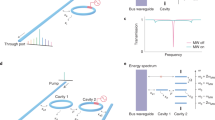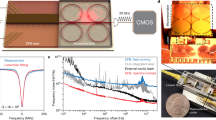Abstract
Optical frequency combs are broadband sources that offer mutually coherent, equidistant spectral lines with unprecedented precision in frequency and timing for an array of applications1. Frequency combs generated in microresonators through the Kerr nonlinearity require a single-frequency pump laser and have the potential to provide highly compact, scalable and power-efficient devices2,3. Here we demonstrate a device—a laser-integrated Kerr frequency comb generator—that fulfils this potential through use of extremely low-loss silicon nitride waveguides that form both the microresonator and an integrated laser cavity. Our device generates low-noise soliton-mode-locked combs with a repetition rate of 194 gigahertz at wavelengths near 1,550 nanometres using only 98 milliwatts of electrical pump power. The dual-cavity configuration that we use combines the laser and microresonator, demonstrating the flexibility afforded by close integration of these components, and together with the ultra low power consumption should enable production of highly portable and robust frequency and timing references, sensors and signal sources. This chip-based integration of microresonators and lasers should also provide tools with which to investigate the dynamics of comb and soliton generation.
This is a preview of subscription content, access via your institution
Access options
Access Nature and 54 other Nature Portfolio journals
Get Nature+, our best-value online-access subscription
$29.99 / 30 days
cancel any time
Subscribe to this journal
Receive 51 print issues and online access
$199.00 per year
only $3.90 per issue
Buy this article
- Purchase on Springer Link
- Instant access to full article PDF
Prices may be subject to local taxes which are calculated during checkout




Similar content being viewed by others
Data availability
The data that support the findings of this study are available from the corresponding authors on reasonable request.
References
Newbury, N. R. Searching for applications with a fine-tooth comb. Nat. Photon. 5, 186–188 (2011).
Del’Haye, P. et al. Optical frequency comb generation from a monolithic microresonator. Nature 450, 1214–1217 (2007).
Pasquazi, A. et al. Micro-combs: a novel generation of optical sources. Phys. Rep. 729, 1–81 (2018).
Jung, H., Xiong, C., Fong, K. Y., Zhang, X. & Tang, H. X. Optical frequency comb generation from aluminum nitride microring resonator. Opt. Lett. 38, 2810–2813 (2013).
Savchenkov, A. A. et al. Tunable optical frequency comb with a crystalline whispering gallery mode resonator. Phys. Rev. Lett. 101, 093902 (2008).
Levy, J. S. et al. CMOS-compatible multiple-wavelength oscillator for on-chip optical interconnects. Nat. Photon. 4, 37–40 (2010).
Razzari, L. et al. CMOS-compatible integrated optical hyper-parametric oscillator. Nat. Photon. 4, 41–45 (2010).
Herr, T. et al. Temporal solitons in optical microresonators. Nat. Photon. 8, 145–152 (2014).
Saha, K. et al. Modelocking and femtosecond pulse generation in chip-based frequency combs. Opt. Express 21, 1335–1343 (2013).
Yi, X., Yang, Q.-F., Yang, K. Y., Suh, M.-G. & Vahala, K. Soliton frequency comb at microwave rates in a high-Q silica microresonator. Optica 2, 1078–1085 (2015).
Yu, M., Okawachi, Y., Griffith, A. G., Lipson, M. & Gaeta, A. L. Mode-locked mid-infrared frequency combs in a silicon microresonator. Optica 3, 854–860 (2016).
Xue, X. et al. Mode-locked dark pulse Kerr combs in normal-dispersion microresonators. Nat. Photon. 9, 594–600 (2015).
Volet, N. et al. Micro-resonator soliton generated directly with a diode laser. Laser Photonics Rev. 12, 1700307 (2018).
Suh, M.-G., Yang, Q.-F., Yang, K. Y., Yi, X. & Vahala, K. J. Microresonator soliton dual-comb spectroscopy. Science 354, 600–603 (2016).
Dutt, A. et al. On-chip dual-comb source for spectroscopy. Sci. Adv. 4, e1701858 (2018).
Yu, M. et al. Silicon-chip-based mid-infrared dual-comb spectroscopy. Nat. Commun. 9, 1869 (2018).
Liang, W. et al. High spectral purity Kerr frequency comb radio frequency photonic oscillator. Nat. Commun. 6, 7957 (2015).
Spencer, D. T. et al. An optical-frequency synthesizer using integrated photonics. Nature 557, 81–85 (2018).
Papp, S. B. et al. Microresonator frequency comb optical clock. Optica 1, 10–14 (2014).
Suh, M.-G. & Vahala, K. J. Soliton microcomb range measurement. Science 359, 884–887 (2018).
Trocha, P. et al. Ultrafast optical ranging using microresonator soliton frequency combs. Science 359, 887–891 (2018).
Marin-Palomo, P. et al. Microresonator-based solitons for massively parallel coherent optical communications. Nature 546, 274–279 (2017).
Fang, A. W. et al. Electrically pumped hybrid AlGaInAs-silicon evanescent laser. Opt. Express 14, 9203–9210 (2006).
Van Campenhout, J. et al. Electrically pumped InP-based microdisk lasers integrated with a nanophotonic silicon-on-insulator waveguide circuit. Opt. Express 15, 6744–6749 (2007).
Kobayashi, N. et al. Silicon photonic hybrid ring-filter external cavity wavelength tunable lasers. J. Lightwave Technol. 33, 1241–1246 (2015).
Lee, J.-H. et al. Demonstration of 12.2% wall plug efficiency in uncooled single mode external-cavity tunable Si/III-V hybrid laser. Opt. Express 23, 12079–12088 (2015).
Ji, X. et al. Ultra-low-loss on-chip resonators with sub-milliwatt parametric oscillation threshold. Optica 4, 619–624 (2017).
Stern, B., Ji, X., Dutt, A. & Lipson, M. Compact narrow-linewidth integrated laser based on a low-loss silicon nitride ring resonator. Opt. Lett. 42, 4541–4544 (2017).
Oldenbeuving, R. M. et al. 25 kHz narrow spectral bandwidth of a wavelength tunable diode laser with a short waveguide-based external cavity. Laser Phys. Lett. 10, 015804 (2013).
Liang, W. et al. Whispering-gallery-mode-resonator-based ultranarrow linewidth external-cavity semiconductor laser. Opt. Lett. 35, 2822–2824 (2010).
Pasquazi, A. et al. Self-locked optical parametric oscillation in a CMOS compatible microring resonator: a route to robust optical frequency comb generation on a chip. Opt. Express 21, 13333–13341 (2013).
Johnson, A. R. et al. Microresonator-based comb generation without an external laser source. Opt. Express 22, 1394–1401 (2014).
Joshi, C. et al. Thermally controlled comb generation and soliton modelocking in microresonators. Opt. Lett. 41, 2565–2568 (2016).
Bao, C. et al. Nonlinear conversion efficiency in Kerr frequency comb generation. Opt. Lett. 39, 6126–6129 (2014).
Yi, X., Yang, Q.-F., Yang, K. Y. & Vahala, K. Active capture and stabilization of temporal solitons in microresonators. Opt. Lett. 41, 2037–2040 (2016).
Cong, G. W. et al. Power-efficient gray-scale control of silicon thermo-optic phase shifters by pulse width modulation using monolithically integrated MOSFET. In Optical Fiber Communication Conference (2015) M2B.7 (Optical Society of America, 2015).
Peccianti, M. et al. Demonstration of a stable ultrafast laser based on a nonlinear microcavity. Nat. Commun. 3, 765 (2012).
Hausmann, B. J. M., Bulu, I., Venkataraman, V., Deotare, P. & Lončar, M. Diamond nonlinear photonics. Nat. Photon. 8, 369–374 (2014).
Webb, K. E., Erkintalo, M., Coen, S. & Murdoch, S. G. Experimental observation of coherent cavity soliton frequency combs in silica microspheres. Opt. Lett. 41, 4613–4616 (2016).
Acknowledgements
We are grateful to S. Miller, C. Joshi, T. Lin, U. Dave and J. Jang for discussions and to M. Yu for help with soliton simulations. We also thank M. C. Shin and O. Jimenez for packaging advice. This work was supported by AFRL programme award number FA8650-17-P-1085; the ARPA-E ENLITENED programme (DE-AR0000843); the Defense Advanced Research Projects Agency (DARPA) under the Microsystems Technology Office Direct On-Chip Digital Optical Synthesizer (DODOS) program (N66001-16-1-4052) and the Modular Optical Aperture Building Blocks (MOABB) programme (HR0011-16-C-0107); the STTR programme (N00014-16-P-30); and the Air Force Office of Scientific Research (AFOSR) (FA9550-15-1-0303). X.J. acknowledges the China Scholarship Council for financial support. This work was performed in part at the Cornell NanoScale Facility, an NNCI member supported by NSF grant ECCS-1542081.
Reviewer information
Nature thanks W. Freude and the other anonymous reviewer(s) for their contribution to the peer review of this work.
Author information
Authors and Affiliations
Contributions
B.S. conceived the work, designed and assembled the devices, performed the measurements, and prepared the manuscript. X.J. fabricated the devices. B.S. and X.J. characterized the microring transmission. Y.O. simulated the soliton combs. M.L. and A.L.G. supervised the project. All authors discussed the results and edited the manuscript.
Corresponding author
Ethics declarations
Competing interests
All authors are listed as inventors in a patent application related to this work, filed by Columbia University.
Additional information
Publisher’s note: Springer Nature remains neutral with regard to jurisdictional claims in published maps and institutional affiliations.
Extended data figures and tables
Extended Data Fig. 1 Comb generation simulation at low optical power.
Shown is the simulated optical spectrum of a soliton comb generated with 700 µW optical pump power (Pin) in the bus waveguide before the microresonator. The microresonator dimensions used in the model are 730 nm × 1,800 nm with a radius of 120 µm, corresponding to a 194 GHz FSR.
Extended Data Fig. 2 Comparison of simulated and measured solitons.
a, Simulation of a single-soliton comb generated with 2 mW optical pump power in the bus waveguide before the microresonator (1.66 mW after the microresonator). The microresonator dimensions used in the model are 730 nm × 1,800 nm with a radius of 120 µm, corresponding to a 194 GHz FSR. b, Optical spectrum of a measured single-soliton comb (from Fig. 3c) with 1.66 mW pump power in the bus waveguide after the microresonator. The sech profile and comb bandwidth qualitatively match those of the simulated comb.
Rights and permissions
About this article
Cite this article
Stern, B., Ji, X., Okawachi, Y. et al. Battery-operated integrated frequency comb generator. Nature 562, 401–405 (2018). https://doi.org/10.1038/s41586-018-0598-9
Received:
Accepted:
Published:
Issue Date:
DOI: https://doi.org/10.1038/s41586-018-0598-9
Keywords
This article is cited by
-
Scalable and efficient grating couplers on low-index photonic platforms enabled by cryogenic deep silicon etching
Scientific Reports (2024)
-
Integrated optical frequency division for microwave and mmWave generation
Nature (2024)
-
Synthetic reflection self-injection-locked microcombs
Nature Photonics (2024)
-
Turnkey photonic flywheel in a microresonator-filtered laser
Nature Communications (2024)
-
Non-planar graphene directly synthesized on intracavity optical microresonators for GHz repetition rate mode-locked lasers
npj 2D Materials and Applications (2024)
Comments
By submitting a comment you agree to abide by our Terms and Community Guidelines. If you find something abusive or that does not comply with our terms or guidelines please flag it as inappropriate.



